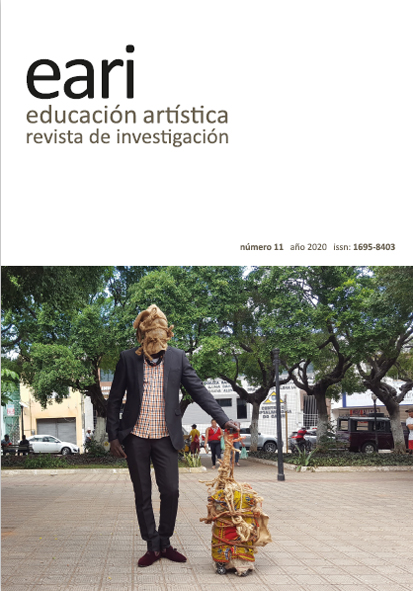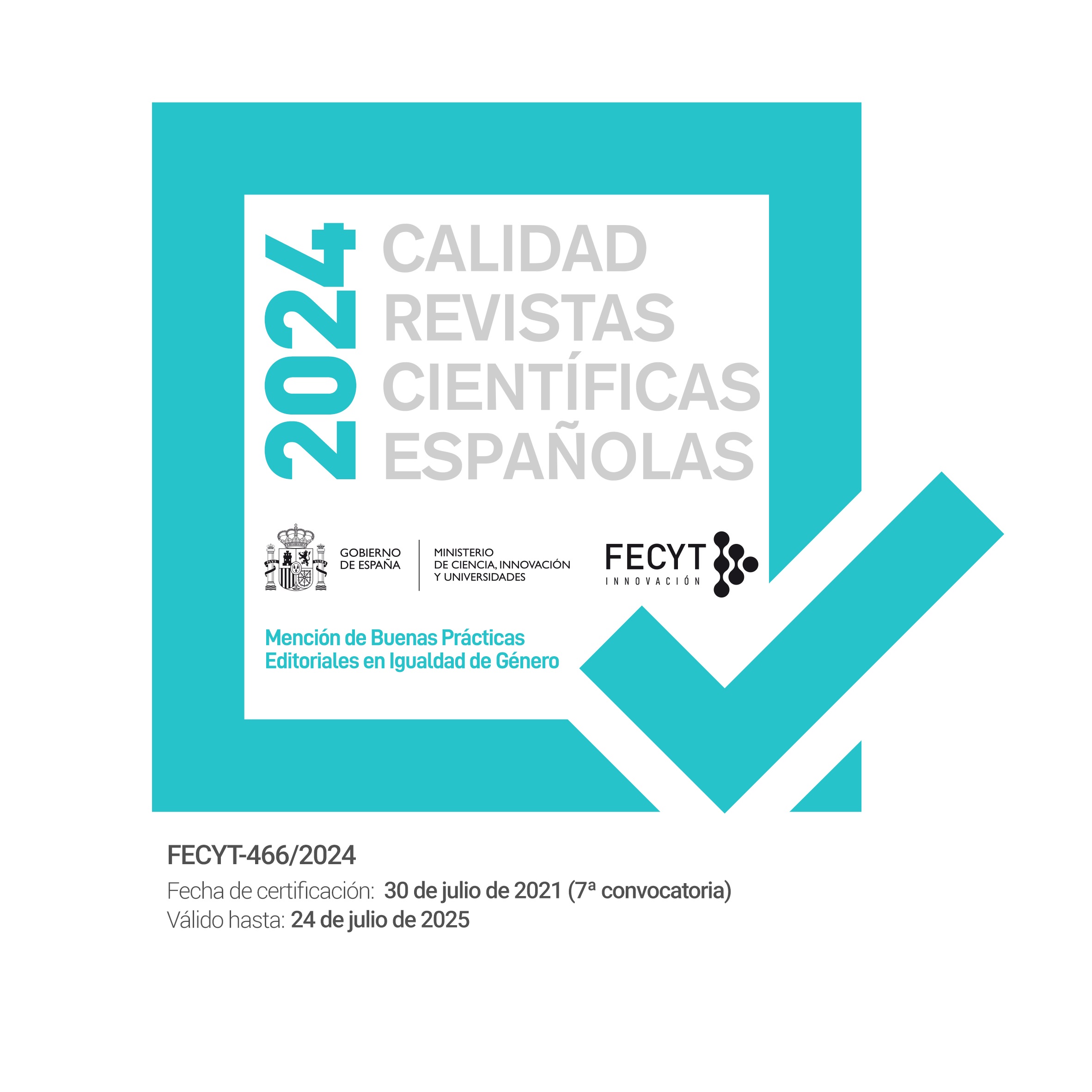The body as a didactic dispositive in the initial teacher training in visual art for secondary education
DOI:
https://doi.org/10.7203/eari.11.17013Keywords:
body, visual arts, art theory, teachers training Abstract
Abstract
This article is based on a pedagogical experience implemented within a visual arts teacher training program, whose future work context will be the secondary education levels in the Chilean school context. Its main objective is to theoretically reflect about the body and its pedagogical possibilities. Since the implementation of a program of visual art teaching and learning that includes the body as a didactic dispositive. Under a methodology of a Learning-Expressive Project were defined three theoretical practical workshops about the body within a visual art teachers training program in Chile. After every workshop it was described the reflection of corporal practice with the theoretical scope of the body politics, the embodiment of professional identity and embodied cognition. As a conclusion, it allows us to reflect on the transition from a disciplinary teaching of the visual arts towards its interdisciplinary integration, intertwining the field of the humanities with embodied human cognition. Finally, three interdisciplinary workshops are suggested that intertwine literature, theater and cinema, based on body language and expression for visual arts teachers initial training programs.
 Downloads
Downloads
 References
References
Alfonso, M. (2012). Aportes a la construccion de la identidad profesional del profesor de teatro. Folios, Revista de la Facultad de Humanidades Universidad Pedagógica Nacional (35), 3-15.
Arévalo, A., Fernández Ll, B., Hidalgo, F., Lepe, Y., Miranda, C., Núñez, M., y Reyes, L. (2016). Corporalidades y narrativas docentes: un dispositivo metodológico para la investigación y formación de profesores. Estudios pedagógicos, 42(4), 223-242.
Barría, M. (2014). Intermitencias: Ensayos sobre performance, teatro y visualidad. Santiago de Chile: Editorial Universitaria.
Bazin, A. (2014). ¿Qué es el cine?. Barcelona: Ediciones Rialp.
Brown, S., and Jordania, J. (2013). Universals in the world’s musics. Psychol. Music, (41), 229–248. https://doi.org/10.1177/0305735611425896
Cárdenas, R.; Lagos, I. y Figueroa, E. (2016). El profesorado de educación básica y su contribución a la enseñanza de las artes visuales en la escuela. Arte, Individuo y Sociedad, 28(3), 475-493.
Castro, J., & Farina, C. (2015). Hacia un cuerpo de la experiencia en la educación corporal. Revista Brasileira de Ciências do Esporte, 37(2), 179-184.
Chen, J.L, Penhune, V.B., Zatorre, R. (2008). Moving on Time: Brain Network for Auditory-Motor Synchronization is Modulated by Rhythm Complexity and Musical Training. Journal of Cognitive Neuroscience, 20(2), 226-239.
Cinzia, D. D., & Vittorio, G. (2009). Neuroaesthetics: a review. Current opinion in neurobiology, 19(6), 682-687
Cortés, L.C. (2018). La performatividad en la acción pedagógica de profesores/as en formación en artes visuales. Atenea (Concepción), (518), 57-73. https://dx.doi.org/10.4067/S0718-04622018000200057
Cortés, L.C., & Grinspun, N. (2019). La importancia del cuerpo en las prácticas pedagógicas en Artes Visuales. Perspectiva Educacional, 58(3), 102-126. https://dx.doi.org/10.4151/07189729-vol.58-iss.3-art.865
CPEIP (2008). Marco para la Buena Enseñanza. Santiago de Chile: Ministerio de Educación. Recuperado el 05 de septiembre de 2019, de https://www.cpeip.cl/marco-buena-ensenanza/
Eco, H. (2010). Historia de la Belleza. Barcelona: De Bolsillo.
Eerola, T., Luck, G. & Toiviainen, P. (2006). An investigation of pre-schoolers corporeal synchronization with music. In, 9° International Conferencia on Musica Perception and Cognition. Alma Mater Studiorum University of Bologna (pp.472-476). Bologna.
Errázuriz, L. H.(2006). Sensibilidad Estética. Un desafío pendiente en la educación Chilena. Santiago de Chile: Instituto de Estética, Pontificia Universidad Católica de Chile.
Foucault, M. (2009). Vigilar y Castigar. Nacimiento de la Prisión. Argentina: Siglo XXI.
Gallo, L. E. (2009). El cuerpo en la educación da qué pensar: perspectivas hacia una educación corporal. Estudios pedagógicos (Valdivia), 35(2), 232-242. http://dx.doi.org/10.4067/S0718-07052009000200013
Gimferre, P. (1985). Cine y literatura. Barcelona: Ediciones Planeta.
Gombrich, E.H. (2004). La Historia del Arte. Madrid: Debate.
González, G., & Martínez, L. (2018). Los Diarios Corporales Docentes como Instrumentos de Reflexión y de Evaluación Formativa en el Prácticum de Formación Inicial del Profesorado. Estudios pedagógicos (Valdivia), 44(2), 185-204. http://dx.doi.org/10.4067/S0718-07052018000200185
Hauser, A. (2016). Historia social de la literatura y el arte I. Desde la prehistoria hasta el barroco. Madrid: Debolsillo.
Horn, S. (2009). Performance art at secondary level. International Journal of Art & Design Education, 28(2), 160-173.
Levitin, D. J., Grahn, J. A., & London, J. (2017). The Psychology of Music : Rhythm and Movement. The Annual Review of Psychology (69),51-75. https://doi.org/10.1146/annurev-psych-122216- 011740
Marshall, J. (2014). Transdisciplinarity and Art Integration: Toward a New Understanding of Art-Based Learning across the Curriculum. Studies in Art Education, 55 (2), 104-127. https://doi.org/10.1080/00393541.2014.11518922
Martín, M. (2005). Del movimiento a la danza en la educación musical. Educatio Siglo XXI: Revista de La Facultad de Educación (23), 125–139. Recuperado desde file:///C:/Users/pc01/Downloads/123-Texto%20del%20art%C3%ADculo-548-1-10-20070312%20(2).pdf
Martínez, S. (2006). El cuerpo político. En Res Pvblica Litterarvm, Documentos de trabajo del grupo de investigación “Nomos” (pp.3-7). Madrid: Instituto de Estudios Clásicos, Lucio Anneo Séneca.
Martinic, S., & Villalta, M. (2015). La gestión del tiempo en la sala de clases y los rendimientos escolares en escuelas con jornada completa en Chile. Perfiles educativos, 37(147), 28-49.
Medeiros, M. P., Gómez, C., Sánchez, M. J., & Orrego, V. (2018). Idoneidad disciplinar de los profesores y mercado de horas docentes en Chile. Calidad en la educación, (48), 50-95.
Micieli, C. (2007) El cuerpo como construcción cultural. Aistehsis, 42 (2007), 47-69. Recuperado de http://revistaaisthesis.uc.cl/index.php/rait/article/view/449
Motos, T. (2005). Desarrollo de la expresión para ser y hacer creativos. En Gervilla Castillo, Ángeles y Bernál Vázquez, Julia (Dirección), Creatividad: aspectos psicológicos, educativos y sociales (pp. 421-433). Málaga: Editorial Dykinson.
Orbeta, A., & Oyanedel, R. (2018). En vías de desaparición. Antecedentes para entender la disminución de las artes en la formación inicial docente de educación primaria en Chile. Arte, Individuo y Sociedad, 30(2), 375. https://doi.org/10.5209/ARIS.57622
Prat, M. T. A., & Brunicardi, D. P. (2017). Las luces de la expresión corporal: Ventajas y posibilidades de los Proyectos de Aprendizaje Expresivos. Educación Física en Secundaria. Retos: nuevas tendencias en educación física, deporte y recreación, (31), 232-237.
Santos Sánchez-Guzmán, E. y Mesas Escobar, E. C. (2018). La creatividad integrada desde el análisis de experiencias artísticas con personas con capacidades diversas en espacios académicos. Revista Complutense de Educación, 29(3), 773-789. https://doi.org/10.5209/RCED.53958
Seitz, A (2000). The Bodily Basis of Thought. New Ideas in Psychology (18), 23–40.
Sennet, R. (2006). Carne y Piedra: El Cuerpo y la Ciudad en la Civilización Occidental. Alianza: Madrid.
Ley n° 20.903, Crea el sistema de desarrollo profesional docente y modifica otras normas. Biblioteca del Congreso Nacional de Chile de 4 de marzo de 2016. Recuperada de https://www.leychile.cl/N?i=1087343&f=2016-04-01&p=
Tejo, C. (2017). Proyectos de arte de acción: análisis de una experiencia pedagógica. Arte, Individuo y Sociedad, 1(1), 203-217. https://doi.org/10.5209/ARIS.47320
Tierney, A. T., & Kraus, N. (2013). The ability to tap to a beat relates to cognitive, linguistic, and perceptual skills. Brain and Language, 124(3), 225–231. https://doi.org/10.1016/j.bandl.2012.12.014
Tran, C., Smith, B., & Buschkuehl, M. (2017). Support of mathematical thinking through embodied cognition: Nondigital and digital approaches. Cognitive Research: Principles and Implications, 2(1), 16.
Zentner, M., & Eerola, T. (2010). Rhythmic engagement with music in infancy. Proceedings of the National Academy of Sciences, 107(13), 5768–5773. https://doi.org/10.1073/pnas.1000121107
Downloads
Published
How to Cite
-
Abstract1579
-
PDF (Español)847
Issue
Section
License
![]()
Educación artística: revista de investigación (EARI) retains the proprietary rights (copyright) of published works, and favors and allows the reuse of the same under the license Creative Commons Attribution-Noncommercial Use 4.0 International License (CC-BY-NC 4.0), which allows third parties to use the published material whenever the authorship of the work and the source of publication is mentioned (journal, publisher and URL of the work), and it is used for non-commercial purposes.
Authors are encouraged to disseminate their work after it has been published, through the internet (for example, in institutional archives online or on its website) which can generate interesting exchanges and increase work appointments.








